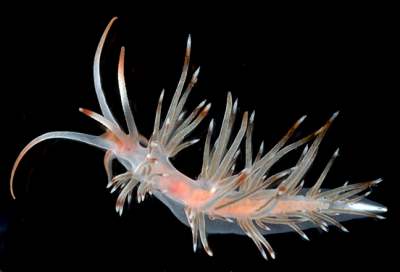
Sakuraeolis nungunoides
Rudman, 1980
Order: NUDIBRANCHIA
Suborder: AEOLIDINA
Family: Glaucidae
DISTRIBUTION
Originally described from Tanzania, East Africa. Also reported on the Forum from New Caledonia & Malaysia, suggesting that it may have a wide Indo-West Pacific distribution.
PHOTO
Lagoon between mainland and Récif de l'Infernet, off Koumac, New Caledonia, 20°34.4'S, 164°13'E, 12m, 18 October 1993, 18mm long alive, AM C200516.
PHOTO: Bill Rudman.
RELATED TOPIC
Defensive coloration in sea slugs
The body is translucent white with tinges of the orange viscera showing through. There is a median orange band on the head from the rhinophores to the oral tentacles. The basal third of the long tapering rhinophores is translucent, the middle third is white, and the upper third orange. The oral tentacles are of similar shape and colour. The anterior edge of the foot and all of the tentacular foot corners are orange, and so is the posterior tip of the foot. The cerata are transparent, or slightly translucent, sometimes with a dusting of white. Near the tip is a broad orange band, the tip itself being opaque white. The thin digestive gland duct is clearly visible and ranges in colour from light greenish brown to a dark chocolate brown.
The animal grows to at least 40mm long. The cerata are usually extremely long, and often held upright. The oral tentacles and the rhinophores are both long and tapering, the rhinophores being slightly shorter. The cerata are arranged in a series of arches down each side of the body, the arches raised on pads out from the body. It feeds on hydroids. In Tanzania it was found feeding on both Salacia tetracythara and Eudendrium sp. cf. carneum.
Many glaucid aeolids are described as being ‘pugnacious’ because they erect their cerata when disturbed. Sakuraeolis nungunoides not only straightens its cerata but it also bristles them, quivering and pointing the red colored tips, containing their cnidosacs, at the source of the irritation. It was this behaviour which caused me to name this animal after the porcupine (Nungunungu in Swahili), which bristles its spines in much the same way when attacked.
-
Rudman, W.B. (1980). Aeolid opisthobranch molluscs (Glaucidae) from the Indian Ocean and the south-west Pacific. Zoological Journal of the Linnean Society, 68: 139-172.
Rudman, W.B., 2003 (May 10) Sakuraeolis nungunoides Rudman, 1980. [In] Sea Slug Forum. Australian Museum, Sydney. Available from http://www.seaslugforum.net/factsheet/sakunung
Related messages
-
Sakuraeolis nungunoides from Philippines
From: Brian Mayes, March 3, 2009 -
Sakuraeolis nungunoides from New Caledonia
From: Jean-François Hervé, August 29, 2006 -
Sakuraeolis nungunoides feeding
From: Erwin Koehler, June 12, 2006 -
Sakuraeolis nungunoides from Sarawak, Malaysia
From: Mike Krampf, June 7, 2006 -
Sakuraeolis nungunoides? from Singapore
From: Lim Han Peng, April 16, 2005 -
Sakuraeolis nungunoides from northern N.S.W.
From: Denis Riek, December 28, 2004 -
Sakuraeolis nungunoides from Malaysia
From: Harry Erhardt, May 10, 2003 -
Sakuraeolis nungunoides from New Caledonia
From: Bill Rudman, May 10, 2003 -
Sakuraeolis nungunoides from Tanzania
From: Bill Rudman, May 10, 2003
